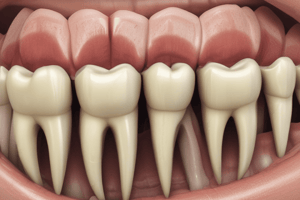Podcast
Questions and Answers
The Step-back technique is used to prepare the entire root canal.
The Step-back technique is used to prepare the entire root canal.
False (B)
The Modified Step-Back Technique is a combination of hand and rotary instruments.
The Modified Step-Back Technique is a combination of hand and rotary instruments.
False (B)
The Step-back technique always requires a dry field.
The Step-back technique always requires a dry field.
False (B)
The Step-back technique provides a gradual taper in the root canal preparation.
The Step-back technique provides a gradual taper in the root canal preparation.
The Step-back technique is a quick and easy procedure.
The Step-back technique is a quick and easy procedure.
The Passive Step-Back Technique reduces the occurrence of procedural errors like transportation of the canal.
The Passive Step-Back Technique reduces the occurrence of procedural errors like transportation of the canal.
The Step-back technique is used to prepare the coronal part of the root canal.
The Step-back technique is used to prepare the coronal part of the root canal.
The Step-back technique is useful for preparing curved canals.
The Step-back technique is useful for preparing curved canals.
The Step-back technique always results in a large apical preparation.
The Step-back technique always results in a large apical preparation.
Recapitulation is an important step in the Step-back technique.
Recapitulation is an important step in the Step-back technique.
Flashcards are hidden until you start studying
Study Notes
Step-Back Technique in Endodontics
- Emphasizes keeping the apical preparation small, in its original position, and producing a gradual taper coronally
- Involves preparation of the apical third initially, followed by the middle and coronal third of the canal using larger instruments
Phases of Step-Back Technique
- Phase I: Apical Preparation
- Evaluate the carious tooth before initiating endodontic treatment
- Prepare the access cavity, locate the canal orifices, and establish the working length
- Use a pathfinder to establish the working length
- Insert the first instrument into the canal with a watch winding motion, remove, and irrigate
- Lubricate the instrument to emulsify fibrous pulp tissue
- Recapitulate the canal with previous smaller number instruments to break up apical debris
- Repeat until a size 25 K-File reaches the working length
- Phase II: Preparation of Remainder of the Root Canal
- Gradually step back while increasing in size
- Insert the instrument into the canal with a watch winding motion, remove, irrigate, and recapitulate
- Use Gates Glidden to prepare the coronal root area
- Refine the root canal with a master apical file using push-pull strokes to achieve a smooth taper form
Procedures in Step-Back Technique
- Set rubber stops on files #15, 20, 25, 30, and 35 at the working length
- Insert files in sequence, filling the root canal with sodium hypochlorite, and using a push-pull stroke with a circumferential motion
- Set rubber stops on files #40, #45, #50, etc., ½mm, 1mm, 1.5mm shorter than the working length, respectively
Important Reminders in Step-Back Technique
- ALWAYS WORK IN A WET FIELD
- IRRIGATE OFTEN
- RECAPITULATE OFTEN
Advantages and Disadvantages of Step-Back Technique
Advantages
- Better tactile awareness
- Keeps apical preparation small in its original position with a gradual taper
- Ability to prepare a proper apical stop
Disadvantages
- Chances of pushing debris into periradicular tissues
- Tendency to straighten the curved canal
- Time-consuming
- Difficult to insert instruments in canal
Types of Step-Back Technique
- Modified Step-Back Technique
- Preparation is completed in apical third of the canal
- Procedure is started 2-3 mm short of minor diameter/apical constriction for parallel retention form at apical area
- Passive Step-Back Technique
- Combination of hand and rotary instruments for adequate coronal flare and apical part preparation
- Provides gradual enlargement of the root in an apical to coronal direction
- Reduces procedural errors like transportation of the canal, ledge, or zip formation
Studying That Suits You
Use AI to generate personalized quizzes and flashcards to suit your learning preferences.




